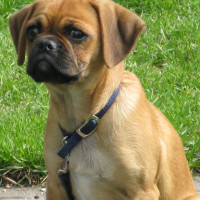Appearance of the Pugalier
|
| As the Pug and Cavalier King Charles Spaniel are very different dogs, it would make sense that their offspring vary enormously. However, most will have a distinctive look that defines them as their own breed. Although the Pugalier is a brachycephalic breed, with a broad, shortened skull, most will develop a longer muzzle and larger nostrils than their Pug parent. Their brown eyes tend to be large and prominent, but not as pronounced as those of the Pug. Although their ears are pendulous, they more closely resemble the Cavalier's wider flaps. Their skull is large for their body and often domed. Their chest is fairly broad, although their body is compact. Their limbs are robust and strong. The Pugalier's tail can be straight like the Cavalier or curled like the Pug. Most will not have the same plume of fur as the Cavalier. The Pugalier's coat is short and straight, except in a few cases where the longer, silkier Cavalier coat is inherited. The vast majority of dogs have a fawn coat with a dark face mask, but individuals can be a mixture of white, red, black and brown. With both parents being small breeds, a fully developed Pugalier usually measures between 25 and 35 cm and weighs between 4.5 and 9 kg. |
Temperament of the Pugalier
|
| With a winning personality, this dog's temperament is what makes it a true superstar. Inheriting the kindness of the Cavalier and the confident, mischievous nature of the Pug, the Pugalier is a fabulous companion for the whole family. They have great patience with children and form strong, affectionate bonds with every member of the family. As well as tolerating children, they do very well with other animals and can thrive in multi-pet households. Curious and always ready to laugh, the Pugalier sometimes assumes the role of family clown and seems to take great pleasure in entertaining others. They enjoy playing games, solving puzzles and generally interacting with other animals and people. Although this is a breed that simply enjoys being in the company of others, it can be a challenge when they are so dependent on interaction that they are no longer satisfied when alone. Separation anxiety is a potential problem and should be avoided at all costs. Because of this tendency, keeping a Pugalier in an unoccupied house for most of the day is not a good idea. So accepting are they of strangers, the Pugalier makes a very poor choice for a guard dog, as they are more likely to welcome a new person with licks and cuddles than to bark at them or chase them away. |
Needs and activities of the Pugalier
|
| While both parent breeds of this hybrid enjoy lounging and snuggling with their humans, they also require some degree of physical activity. The Pugalier will benefit from daily exercise, which can include walking, indoor and outdoor play and trips to the dog park. It's important that your dog doesn't engage in overly strenuous exercise, such as a long run or hike. Since hybrids don't require a lot of physical activity, they'll do just fine in an apartment and won't need a yard. As the Pugalier is good at light activity, it makes an excellent pet for those who aren't very active. |
Maintenance of the Pugalier
|
| The Pugalier doesn't require much maintenance. The breed will generally require minimal grooming. However, if your dog inherits the coat of its Cavalier parent, more grooming may be required. For those who inherit the Pug's short coat, brushing should take place once a week, two to three times a week is preferable for those who inherit the Cavalier's coat. Dogs with many wrinkles should be wiped with a clean, damp cloth to avoid developing a skin infection. Pugalier dogs will shed all year round, which will require some maintenance of your furniture, carpets and clothes. As with all dogs, you'll need to brush his teeth several times a week to ensure long-term dental health. |









 English (United Kingdom)
English (United Kingdom)